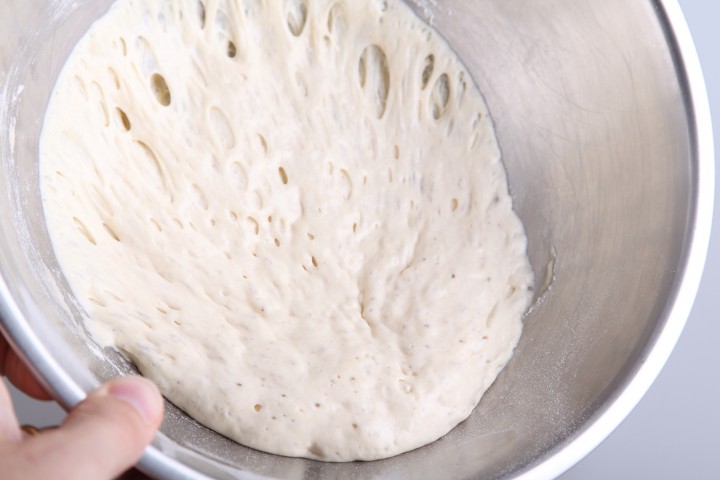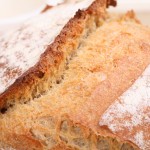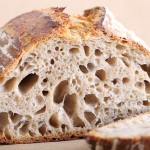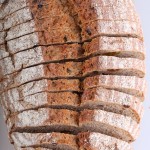
When is it ever NOT a good time to make pizza?!
Note: This posting is from quite a while back. If you want to know how we like to make pizza now, Check out our latest pizza baking and dough making with our new oven here!
If you are a novice to pizza making or you just want to make a good and quick pizza dough check out our recipe for basic pizza dough.
If you are not stressed for time and are looking for good taste, try and make this pizza dough, using a poolish preferment. A poolish is made in a minute, the only thing is you have to think in advance. You can make the poolish anywhere between 8 and 16 hours before you start making the final dough. The most logical choice here would probably be the 8 hour option: you make the poolish in the morning, the final dough in the evening. You can see in the list below how much, or rather how little, yeast you need in combination with the prefermenting times. The amounts of yeast can really only be measured with a precision scale. This recipe will allow for 4 pizza’s, but can easily be doubled of course.
- up to 8 hours 0.3 g instant yeast
- up to 12 hours 0.2 g instant yeast
- up to 16 hours 0.1 g instant yeast
A teaspoon of instant yeast weights about 3,1 grams. So half a teaspoon is 1,5 grams, a quarter teaspoon is 0.77 and one eight teaspoon is 0,39 grams. So for the ‘biggest’ amount you need less than one eight teaspoon, for the other options even less. You can see why we prefer scales…

Making the poolish
Ingredients for the Poolish
100 g wheat flour / bread flour / 00 pizza flour
100 g / 100 ml water
0.3 g instant yeast (see list above)
Flour, water, tiny bit of yeast, stir, wait a while: poolish!
Make the poolish by mixing flour, water and yeast with a spatula or dough whisk until well combined (about 30 seconds). Cover the bowl and leave to develop at room temperature for 8 hours.
Making the pizza dough
Ingredients for the Pizza Dough
makes 4 pizza’s
the poolish from step one
250 g wheat flour / bread flour
8 g sea salt
5 g instant yeast
approx 120 ml water, lukewarm
flour for dusting the peel (semolina flour or cornmeal would be ideal)
Scoop the prepared poolish in the mixing bowl of your standing mixer. Add the flour, salt, and instant yeast. Now add water and knead with dough hook for 7 minutes, or until the dough is smooth and slightly sticky (by hand it will take a bit longer, 10 to 15 minutes, depending on your technique). The dough should clear the sides of the bowl but stick just slightly to the bottom of the bowl. Transfer the dough to your worktop, very lightly dusted with flour. Prepare a sheet pan by misting it with spray oil or by lining it with parchment / baking paper. Using a dough scraper, cut the dough into 4 equal pieces. Lift each piece of dough and gently form it into a ball. Transfer the balls to the pan and cover with floured or greased plastic foil. Leave to rest at room temperature for 1 hour.
At least 45 minutes before making the pizza, place a baking stone on the floor of your oven, or on a rack in the lower part of the oven.
Preheat the oven as hot as possible, (most ovens won’t go higher than 300ºC / 570ºF). For our pizza baking we use the Bestron Alfredo pizza maker, it has a stone and two heated spirals and can reach temperatures above 350ºC / 660ºF and works really well for us. We have had ours for many years now, but we understand the newer models have some sort of heat restriction, so may not work as well as our trusty old Alfredo.
Place the dough balls on top of a floured counter and sprinkle them with flour; dust your hands with flour. Take a ball of dough and using your hands gently press it into a flat disk. Now you can try tossing the dough like a real Italian pro but this is a skill that requires some practice (I can’t do it). You can, like most people, resort to using a rolling pin and roll and stretch the dough into a round shape of about 25 cm /10 inches. Now place the pizza on the peel or pan, making sure there is enough (semolina) flour to allow it to slide. Lightly top it with sauce and your other ingredients of choice (start with 3 or 4 ingredients, keep it simple to give the crust a good chance to bake).
Slide the pizza onto the hot stone and close the door. Keep an eye on it and see if after 2 minutes or so it needs to be rotated for even baking. The pizza should take about 5 to 6 minutes to bake.
Remove the pizza from the oven and transfer to a cutting board. Wait a minute before slicing and serving, to allow the ingredients to set.
Enjoy!









Jeremiah Stecklein says
With this recipe, can 00 flour be used inplace of regular bread flour?
Weekend Bakers says
Hello Jeremiah,
You ‘stumbled upon’ a posting of ours from quite some years back and that is why we mentioned the link at the top of this recipe, to point people to the way we make pizza and pizza dough now! (See: www.weekendbakery.com/posts…gh-recipe/) and with Italian pizza flour. Both recipes work well, but the new one is closer to the Neapolitan style pizza.
Maarten says
Beste mensen,
Wat een leuke serie van verslagen van jullie brood avonturen!
Vraagje: Ik heb al een aantal pogingen gedaan een focaccia te maken met een recept wat in feite een combinatie is van jullie 2 pizzarecepten. Dus een poolish in combinatie met een hard bloem. Probleem is tot nu toe dat het lijkt of de rijs stilvalt na het maken van het definitieve deeg na de eerste keer vouwen. Ik denk dat de totale hoeveelheid gist op een bepaald moment teveel is, waardoor alle gluten worden opgegeten?
Ik had de laatste x een poolish gemaakt op basis van160 g W325 bloem met 0,5 g vers gist (kamertemp/ 12u).
Daarna het deeg afgemaakt met 240 g van hetzelfde bloem en nog eens 0,5g gist. Na verdubbeling (na 5 uur kamertemp) teruggevouwen. Nog een keer laten verdubbelen (2,5 uur) in de vorm gebracht. Maar daarna leek er niet veel meer te gebeuren.
Wat zouden jullie aanraden? Ik zat zelf te denken om de tweede x helemaal geen gist meer bij te voegen.
Een vriendelijke groet,
Maarten
Amsterdam
Weekend Bakers says
Hallo Maarten,
Het deeg kan over-rezen zijn, maar dat zou ook goed te zien moeten zijn, door de kwaliteit van het deeg als je ertegen aan duwt. het zal alleen nog maar inzakken en niet meer opveren of zelf ‘leeglopen’.
Je combineert hier eigenlijk twee dingen die wij niet zouden combineren. Wij zouden of een poolish gebruiken in een deeg dat je daarna wat sneller ontwikkeld of het hele deeg langzaam laten ontwikkelen zoals bij het pizzadeeg recept dat wij tegenwoordig het meeste gebruiken:
www.weekendbakery.com/posts…gh-recipe/
Je ziet in het schema welke hoeveelheid gist je kunt gebruiken bij welke temperatuur en tijd.
Een favoriet focaccia recept van ons is deze:
www.weekendbakery.com/posts…-focaccia/
Dit deeg is echt fantastisch leuk om te maken.
Succes ermee en vooral veel plezier en afleiding!
Ed & Marieke
Sivan rachel says
Hello
Thanks foe that article
I wander if i want to use rye flour for the biga and spelt flour for the the dough after, is that will work?
There is a change with the yeast?
You think its can work?
Thank you so much
Sivan
Weekend Bakers says
Hello Sivan,
Have you ever made pizza dough or the recipe as described above?
We ask this because it is challenging to make a good pizza with different flour, especially rye and spelt because of the lack of gluten and difference in extensibility of the dough. So we would advice, that if you want to try a different flour, you first only use a small % of a different type and see how that goes. You will not have to change the yeast amount when using other flour.
Serena Lee says
Can I freeze the dough to be used for another day?
Weekend Bakers says
Hello Serena,
We never do this, but it is indeed possible. We think it would be best to use risen dough and make portions for easy use.
Good luck with it!
Yesenia Castillo says
Hello! 2 questions:
1. Can I replace the poolish with a sourdough starter made with just flour and water (no yeast added)?
2. Can I replace the instant yeast with active dry?
Thank you for your awesome recipes!!
Weekend Bakers says
Hi Yesenia,
Sorry fr the late reply. Yes you can certainly do that, but we cannot give you the exact amounts and times for perfect development because we never make sourdough pizza. We think our sourdough pita can be used as a good starting point. www.weekendbakery.com/posts…ough-pita/
If you want to replace instant yeast with active dry you need to multiply the instant yeast amount by 1.2 so use about 20% more.
Enjoy your baking!
Billy says
Why do u still use dry yeast? I thot the poolish replaced the need for any yeast at all?
Smdh
Weekend Bakers says
Hello Billy.
It totally depends on the recipe, the amount of poolish, the time you take, the temperatures, if you use the fridge and the time for the final rise / proofing.
So in this case, the (amount of) poolish used and the method, calls for yeast to be used in the final dough, although you use less than you would with a straight dough. The yeast is used to speed up the process, if you use non in the final dough, you need to take extra time for the dough to develop.
If you look at our latest and current favorite way of making pizza dough, you can see that the dough develops with less yeast over 24 hours, but here you make the total dough ‘in advance’.
Enjoy your dough making and pizza baking!
Andrea from Italy says
I would strongly advice to learn how to stretch your pizza in one of the traditional ways, there are more than one, and avoid the use of the rolling pin. It is not hard to learn and you can find plenty of videos that teach you how to do it. The process, whatever method you use, is in 2 phases, first you press from the center to the edges using the finger tips, this moves the gasses formed while proofing in the zone that will become the crust, then you stretch the pizza, stretching, not pressing, to obtain the final dimension.
I can see that you used the rolling pin looking at the crust even before reading the text, is not even, quite flat but in some spots where there was big bubbles of gas. Without the rolling pin the crust would have been much more even, high and with a combo of big and little bubbles inside.
It is really not hard to learn it, after looking at a couple of video that show the process i was able to obtain a good result, maybe not a perfect Giotto circle, but a crust well and evenly rise after only a couple of failures.
A well kneaded and proofed dough is fundamental, other way the gluten net will be not enough strong and you will risk to have some holes in the middle of the pizza, but good kneading and proofing are anyway needed to get a good, healthy and tasty pizza, so it should not be a problem.
An other tip, your recipe is correct, but probably if you want a Neapolitan style pizza a little more hydration is needed using a little oven like yours, it makes also the stretching process easier as the dough is slightly less elastic, anything from 65% to 70% of hydration should work well with the temperature and cooking time of your oven. Maybe 65% to start as with 70% is more difficult to knead and manipulate the dough.
I hope that those tips can help you and your followers to make even more delicious pizza.
Andrea from Italy
Weekend Bakers says
Hello Andrea,
First of all, thank you so much for sharing your knowledge and experience on the subject. Much appreciated!
You ‘stumbled upon’ a posting of ours from quite some years back and that is why we mentioned the link at the top of this recipe pointing to point people to the way we make pizza and pizza dough now! (See: www.weekendbakery.com/posts…gh-recipe/) and with Italian pizza flour. You will probably recognize much more of your own method in it and will be pleased to know we do not use a rolling pin anymore too!
Thank you again and wishing you enjoyment baking and sharing pizza in beautiful Italy!
Greetings from the low countries,
Ed & Marieke
Simon says
Is it possible to make this recipe with sourdough culture instead of instant yeast?
Weekend Bakers says
Hello Simon,
Yes it is, but we never do this because we are not the biggest fans of sourdough pizza. So based on experience we cannot tell you the exact amount of sourdough needed in the poolish for the best result. If we would do this we would take our latest pizza dough recipe and make this (24 hour) dough with the addition of 15 to 20 grams culture. Maybe you can give it a try:
www.weekendbakery.com/posts…gh-recipe/
Simon says
Ok thank’s!
Elizabeth says
I have enjoyed so many delicious pizzas thanks to this recipe! I usually make the poolish day 1, mix it into the rest of the dough and knead on day 2, then put it into the fridge (without a rise) for 12-24 hours and enjoy pizza on day 3. It’s a bit of a wait, but very little effort on each day.
Thank you for your perfect recipe and experimentation!
Weekend Bakers says
Thank you Elizabeth for the generous feedback!
Recently we have been experimenting some more with a new pizza oven and pizza dough recipe. Maybe you would like to give it a try and compare:
www.weekendbakery.com/posts…gh-recipe/
Enjoy your baking, sharing and eating!
Bhavana says
If I don’t want to make pizza right away then can I just bake the base and use when required
Weekend Bakers says
Hello Bhavana,
We would not recommend that. If you only bake a base (just try it one time and see what happens) without topping large bubbles will form all over the surface. Next to that the topping will not be cooked with the pizza. Fresh really is best we think!
Bhavana says
Thanks will surely try
Mark and Isobel says
Dear Ed and Marieke, Your pizza recipe is wonderful. My wife and I have struggled for years to achieve the taste and texture of your poolish pizza. We have had so many disappointing results even using our garden wood fired oven. The internet is overloaded with recipes that are basically so similar (poolish ones included) that they are virtually redundant. However, when tried out they disappoint.
A successful pizza had become our holy grail. We had in desperation decided to book a pizza course in Italy this Spring. Well now no need for that now – We will just enjoy our holiday there with the smug confidence that we are pizziaolas ourselves thanks to you two!
Mark and Isobel
Weekend Bakers says
Hello Mark and Isobel,
Wow, we are truly chuffed about your comment. Excellent. So glad we could provide you with a recipe that works for you. Enjoy your wood fired oven at home and the journey to Italy and the food and hopefully nice weather over there. Nothing to complain about we would say 😉
Greetings from cold and rainy Holland,
Marieke & Ed